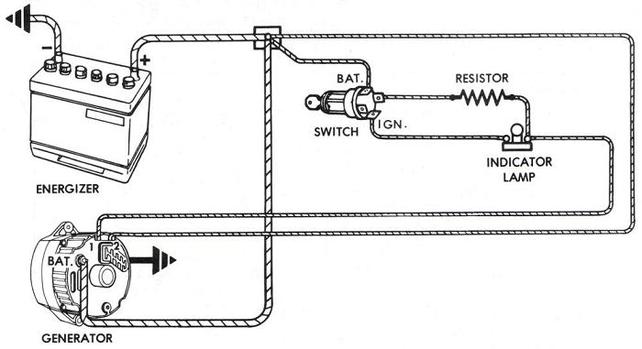My 88 to 98 schematics show the brown wire going to the dash plug and the 99 goes to the PCM or VCM which excites the brown wire.
I found this on the internet which I believe is true. He states that the brown wire runs to the charge light in the dash and gets it's exciter voltage through the power in the light and it needs the lights resistance to work.
All the exciters in all the GM trucks use a resistance wire to excite the alternator
and the earlier ones came from the key switch on the acc terminal.
The brown wire has to have some resistance to keep from frying the diodes in the alternator which may have been the reason your buddy fried three of them when he ran the brown wire to a key on source. Just run your brown wire to the charge light in the dash or through a resistor in series with the key on voltage source and it should work fine. Use any resistor more than 35 ohms and 1 watt up to 300 ohms. Painless wiring recommends an 85 ohm 1 watt resistor.
I assume you have the 71 gauge cluster or the idiot light cluster but either one has the resistance wire off the key switch but the gauge cluster doesn't have the idiot charging light and even if it did it is only 10 ohms so you still need to add a resistor in series with the brown wire to the alternator. The CS series alternators need more than 10 ohms to protect the diodes.
here is his post.
Every 1988 - 1995 C/K truck I've seen with a V8 has had the same alternator; one wire goes to the battery to charge it, and there is a plug with one wire in it that clips into an actual connector on the alternator, NOT spade terminals like older model alternators. Most of the information I've found on Chevy alternators lists a one-wire or three-wire alternator; the one-wire is self-exciting and only has the wire going to the battery, and the three-wire has two blade terminals in addition to the battery wire; one terminal is used for the battery light/gauge, and one terminal is used to excite the regulator.
This two-wire model our trucks use (which I'm pretty sure applies to at least everything '88-'95, since the plug is part of the wiring harness)has the battery wire, and one wire going to the the little plastic plug that clips onto the alternator. They are internally regulated. After some reading I did find the answer I was looking for, so I'm going to share it here for anyone else who might need to know.
The wire that goes into the regulator plug comes from the battery warning light (not necessarily the gauge). When the key is turned on, the warning lamp receives 12v switched power from the battery, and the ground from the bulb is connected to the one wire running to the alternator. The bulb adds a load to the circuit, so its not an exact 12v at the actual regulator plug; I measured on my actual truck, and with the key on you should get 10v. Voltage from the battery light actually excites the regulator.
So, when the key is off, the light doesn't receive any power and stays off, and the regulator doesn't excite. When the key is on, voltage runs through the battery lamp, illuminating it, and grounds through the regulator, exciting it. Once the engine cranks, +12 volts is still applied to the battery light, but the action of the regulator feeds back +12 volts to the other side of the lamp when the regulator is activated and the alternator is in charge mode. With 12+ applied to both sides of the lamp, no current flows and it doesn't illuminate. Thats why if the regulator fails or the alternator doesn't produce a charge, the light will illuminate; the balancing voltage won't be sent back to the bulb to keep it from illuminating.
For my retrofit application, I'll have to wire up that one wire to the GEN light in the dash; I thought I had it that way, but over the course of 35 years its possible the bulb is history. So an interesting note; if the regulators in these alternators aren't being excited, it could possibly be caused by the battery warning lamp bulb going out in the cluster. For anyone who stumbles across this thread in a search, just watch for the battery light to come on when you turn the key on without starting.
Here is a diagram showing how the exciter wire is wired in the early trucks.
It is modified to show how it wires to the internal regulated alternators.

This one shows the resistor wire and the light and it goes to an SI style alternator but yours is a CS with just the brown wire so you won't need the S terminal wire which is the voltage sensing wire. Your alternator has the voltage sensing internally.
I don't normally read the newer truck forums but I look at the electrical forum and the 67 to 72 forum almost every day. i will check this one to see how you made out.